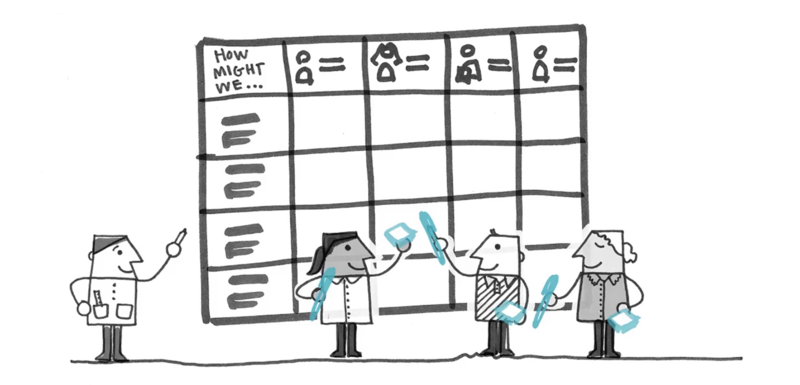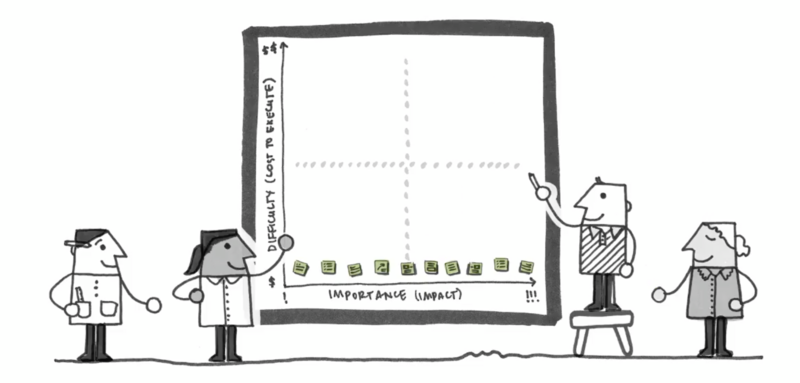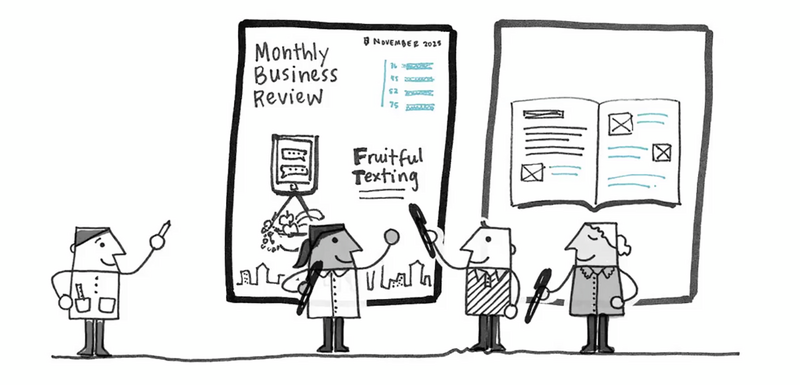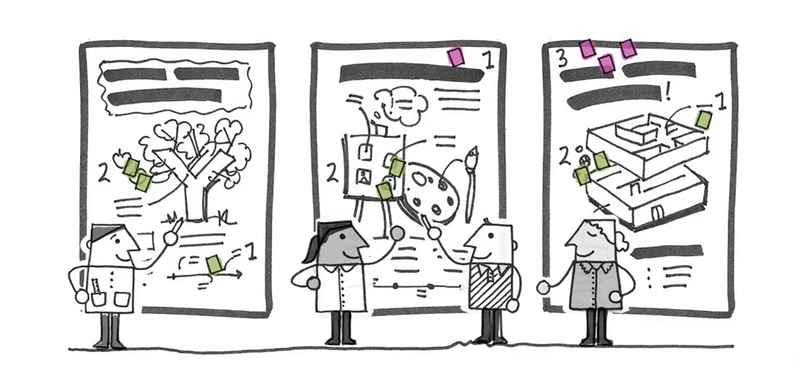ATD Blog
Explore and Assess Future Ideas—in Just a Morning or Afternoon
Wed Oct 25 2017

Evaluate Your Ideas Using an Importance/Difficulty Matrix
In an importance/difficulty matrix, the group evaluates the top 10 or 12 ideas by the relative weight of two consideration sets—how important it is (impact) and how hard it is.
To consider relative importance, place each item along a horizontal axis, the more important to the right, the less important to the left. No ties are allowed—it’s important for the team to align on what impact and difficulty mean early on. Next, assign a relative level of difficulty along the vertical axis—the lower the easier, the higher the harder, again with no ties allowed.
Take notes to capture valuable insights as the group wrestles with the relative importance and difficulty of each idea. Someone from customer insights may have very different views from a colleague focused on implementation.
Figure 2. Importance/Difficulty Matrix


Every company will face some type of milestone event, whether it’s proactive, like a new rebranding campaign, or an unwelcome surprise, like a competitor’s new technology disrupting your top product line.
Milestone events understandably demand immediate attention, but they also offer senior leaders a critical opportunity to explore a long-term strategic question: What do we want our organization to look like years from now?
Human-centered design offers a powerful way for stakeholders to create that shared vision by using four collaborative activities to explore and assess future ideas—all in a three-hour work session.
Getting Started
First, identify the right stakeholders to participate—your core strategic leaders, plus those go-to individuals who get things done in key areas. The ideal group size is between four and 12 people. Consider designating one person (a trusted partner) as session facilitator to guide the activities and keep the group on track and on time.
Schedule three hours when everyone can attend, and pick a dedicated space for the session. Because the goal is generating future ideas, pick the future point of time (10 years out? 20 years? 30 years?), and let everyone know in advance to have that timeframe in mind.
Write out your overarching question and post it prominently in the room to anchor the session.
Spark New Ideas Using a Creative Matrix
Start the session with a creative matrix to quickly generate many new and unconventional ideas. Set up a grid with columns for challenge statements—such as strategic goals for your organization—written as “How might we . . . ” statements, and rows for enabling factors—such as trends within your industry or new technologies affecting customers.
Create teams of between four and six people. Give everyone 15 minutes to generate as many ideas as they can, without constraint, with at least one idea in each square. Encourage wild ideas—anything is possible!
When time is up, each team should share out each idea very quickly (so they don’t get bogged down) then pick two or three ideas for the next activity. The group should end up with between 10 and 12 ideas total.
When creating the teams, be sure to mix people from different areas and roles to ensure diverse perspectives.
Figure 1. Creative Matrix
Bring Concepts to Life Using a Cover Story Mock-Up
Use the ideas that emerged as most important on the importance/difficulty matrix for the next activity—a cover story mock-up. Here, the team does a visual fast-forward by creating magazine covers that depict your organization in your future year. Give the team complete freedom to envision what your company would look like, no constraints.
For smaller groups, have each person work individually; for larger groups, have people work in pairs. Give everyone 30 minutes to draw a magazine cover showing the successful future of your ideas—with sketches, headlines, subheads, charts, and so on to highlight key points and outcomes.
When time is up, have each individual or pair share their cover story mock-up in two minutes or less, explaining their story and key points.
Pay close attention during presentations to hear meaningful insights on how people see the possibilities and learn where their individual passions lie.
Figure 3. Cover Story Mock-Up

Illuminate Preferences Using Visualize the Vote
Visualize the vote allows the group reach alignment on the cover story mock-up ideas. Post all the cover story mock-ups in a row. Give each person three voting sticky tabs—one of color A for the overall vote, and two of color B for detail votes. Allow a moment for everyone to individually consider two things: Which cover story mock-up has the most overall merit, and which specific details to call out for future exploration.
Ask everyone to vote at the same time (use “one, two, three, go!”) by placing the overall voting tab on the cover story mock-up they feel has the most merit and two detail tabs on specific elements.
Ask everyone to explain quickly how they voted and why, focusing on the top vote-getting cover story mock-up. If there is a close second place, ask those who voted for it to explain why. For the detail votes, look for vote clusters and ask for explanations, but be sure to talk through each detail vote to learn why it was called out.
It’s essential that everyone vote simultaneously so no one can just follow what the top-ranking person does, and no one can swing the results by waiting to see where everyone else votes.
Figure 4. Visualize the Vote

Wrapping Up
Thank everyone for contributing their time, perspectives, and ideas to help create a future vision for your company. Assure everyone their views are important and that their voices will be heard.
You should also be clear on what the next steps will be, even if that’s to say more work is needed determine how to proceed. An additional session likely will be necessary to consider which ideas to pursue and who will own that work. Additional human-centered design methods (available on www.LUMAworkplace.com) may be used to do further research before making final selections.
Find step-by-step instructions, an agenda, activity templates, and a materials list on lumaworkplace.com.
